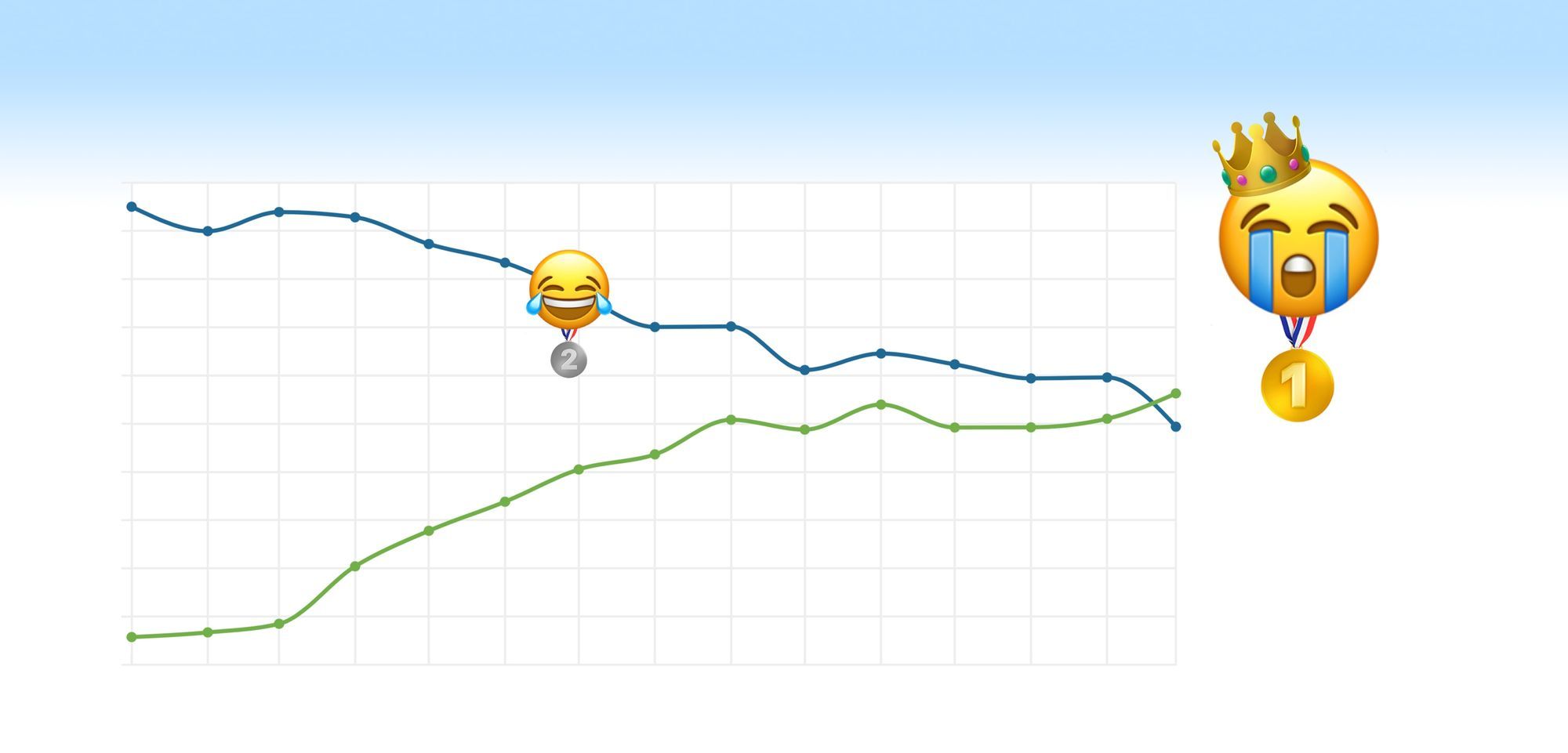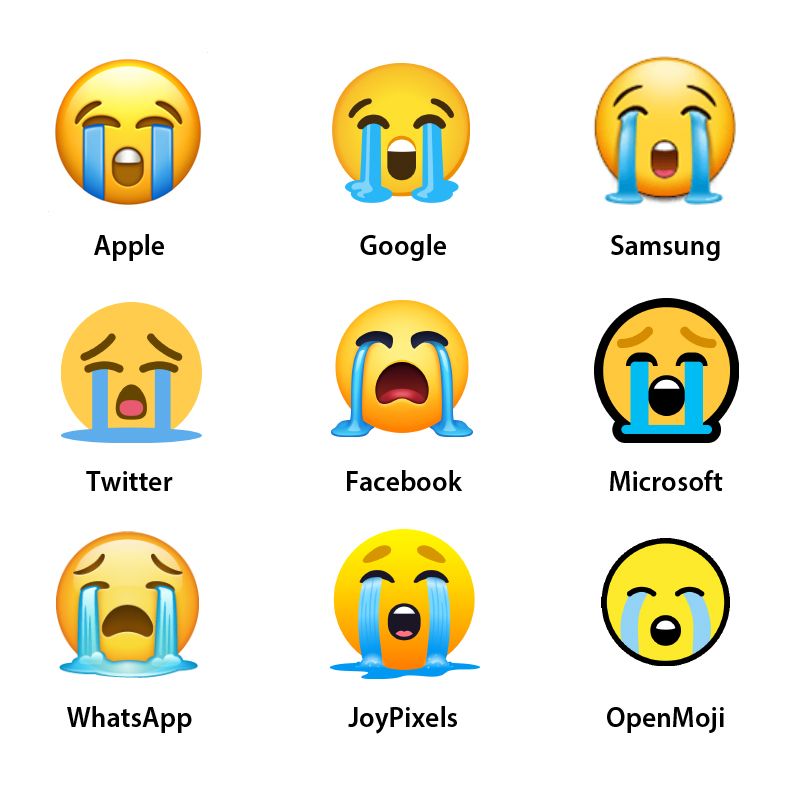😭 Loudly Crying Becomes Top Tier Emoji

To be clear, despite the date of publishing, this is not an April Fool's joke. There's a new top emoji in town.
After years of dominance the laughing crying emoji has been dethroned as Twitter's top emoji. In its place today is another teary-eyed smiley: 😭 Loudly Crying Face.
This is the first time an emoji other than 😂 Face with Tears of Joy has been the most used[1] on Twitter on a month-by-month basis[2].
Above: 😭 Loudly Crying Face has overtaken 😂 Face with Tears of Joy as the most popular emoji on Twitter.
Is this the beginning of the end for 😂 Face with Tears of Joy or just a blip? Data suggests 😭 Loudly Crying Face might be the top emoji by an even greater margin in future.
Why now? 🗓
The toppling of 😂 Face with Tears of Joy comes not long after we here at Emojipedia mused whether or not this seemingly evergreen emoji was being "cancelled" by Gen Z emoji users in favour of alternative means of emojifying laughter and amusement.
Prominent media attention highlighted this trend to those of us beyond Tiktok, with a pushback on the laughing-crying emoji that has been #1 for so long.
Is the story here that 😭 got more popular, or simply that 😂 has become less popular? It appears to be a bit of both.
Getting some very passionate emails about my 😂 emoji story. Just here to say I don’t make the rules folks!! (and I still use this emoji frequently and refuse to burn my skinny jeans) 💀https://t.co/VGvi6CmGZJ
— Kaya Yurieff (@kyurieff) February 15, 2021
Looking at the data, we can see that 😂 Face with Tears of Joy has been stalling in growth for quite some time.
Gen Z's relative dislike of 😂 compared to older generations may factor in here, but it would be remiss of us not to mention the ongoing global pandemic as another potential factor. Is there simply less to laugh about now?
Above: 😂 Face with Tears of Joy has has been declining on Twitter for years.
This does bear out in our data. We can see from April 2020 onwards 😂 Face with Tears of Joy begins to experience a more rapid month-on-month decline than experienced between the peak of its usage on Twitter (June 2019, according to our data) the classification of COVID-19 as a global pandemic by the World Health Organisation in March 2020.
There does definitely appear to be a correlation here[3], but whether the pandemic, Gen Z, or a currently unknown third variable was the most significant factor in the decline of 😂 Face with Tears of Joy is uncertain.
There has been suggestion that Face with Tears of Joy may have simply been a victim of its own success. So successful, people are tired of seeing it.
Comparing the top two emojis since the start of 2020 might show the impact of the pandemic on emoji use, or an unrelated shift in emoji use that happened to take place at the same time.
Above: 😭 Loudly Crying Face saw consistent growth since April 2020.
Note the considerable jump in use for 😭 Loudly Crying Face between March 2020 and April 2020.
On the face of it[4], this rapid increase in usage for 😭 Loudly Crying Face makes sense: it is, after all, a face with an open mouth wailing and streams of heavy tears flowing from closed eyes.

Above: a comparison of 😭 Loudly Crying Face designs across active emoji vendors.
Before we boldly claim that 😭 Loudly Crying Face has become #1 due to the pandemic, it's important to note that this same emoji is also used for laughter.
Why 😭?
As discussed previously in our own "Emojiology" series, the name of 😭 Loudly Crying Face belies its broad usage contexts.
While it can of course be used to express the sadness or grief usually associated with such a volume of tears, many emoji users view its expression as being overly melodramatic.
For some people, 😭 is simply a better laughing emoji than 😂. And that's okay. There's no single right or wrong way to use an emoji.
Some feel quite strongly that it shouldn't be used to convey sadness at all. After all, there are many emojis which appear to convey a more sincere form of sadness than 😭 Loudly Crying Face.
Use these emojis for crying
— Jasmyn (@JasmynBeKnowing) September 9, 2017
😪😰😢😥
Not this emoji
😭
That one is "OMG so funny I'm crying."
I'm so sorry for your loss 😭😭
Looks messed up.
That's not to say some people aren't still confused as to how exactly this came to pass. How we use emojis evolves over time, coming in or out of fashion or switching to an opposite meaning, just as many words have in years gone by.
How did we turn “ 😭” into a laughing emoji...
— Skai (@skaijackson) March 31, 2021
So while it does appear that the pandemic significantly increased the use of 😭 Loudly Crying Face across the globe[3:1], its increase in use cannot exclusively be attributed to sadness or frustration.
In fact, recent instances of its use alongside the 💉 Syringe emoji indicate the joy and relief of someone (either the person themselves or a loved one) finally receiving one of the COVID-19 vaccinations.
Receiving my first blessing from our lady of Moderna this afternoon! 😭💉
— Margarita Diaz (@diazmarg) March 25, 2021
My 95-year-old grandpa who lives in New Jersey *finally* got vaccinated today (with the Johnson & Johnson shot!), and I got my second dose of Pfizer today.
— Annie Wofford (@annie_woff) March 24, 2021
For the first time, I actually have hope that I might get to hug him again. Today is a GOOD day. 😭💉
We Love Context 😭
The third most popular emoji on Twitter is 🥺 Pleading Face, and it shares many traits with 😭 Loudly Crying Face.
Both are flexible and have a wide emotional range. Both don't have one clear meaning, so see a variety of use.
Recent usage of 😭 Loudly Crying Face shows that it has tears that are truly versatile. This one emoji can be seen as happy or sad depending on the context. Proud, or embarassed. Love or grief. No wonder 😭 is popular.
Above: Top ten emojis on Twitter in March 2021.
To put all of this in context, we mapped the usage trends of the current top five emojis to get a feel for the emoji zeitgeist.
In March 2020 🥺 Pleading Face was showing a considerable rise in use making us question if it was perhaps on track to be the number one emoji in 2021. Spoiler: it wasn't. 😭 Loudly Crying Face took that spot.
😭 Loudly Crying Face, like 🥺 Pleading Face, can be used in a melodramatic fashion that may not be immediately obvious from its name or design.
Above: Comparing use of the top five emojis on Twitter between June 2018 and March 2021.
Also notable in these trends is the fact that 🤣 Rolling on the Floor Laughing did not experience the same decline that the 😂 Face with Tears of Joy during the coronavirus pandemic. Instead, it remained largely stable since being outstripped by 🥺 Pleading Face in January 2020.
This stability throughout the pandemic could well indicate that COVID-19 was not as significant a factor in the decline of 😂 Face with Tears of Joy than we might have initially suspected. If we're simply laughing less, then such a decline should have also been experienced by 🤣 Rolling on the Floor Laughing.
😭 Crying Conclusion
What we're likely seeing here is a confluence of factors:
- 😂 Face with Tears of Joy has become over-exposed due to being the top emoji for the past decade[5]
- 😭 Loudly Crying Face is more versatile, with emerging use as both laughter or sadness, depending on context. It's doing double-duty, and this has seen it become number one
- COVID-19 may have reduced the number of times we want to 😂😂😂 and increased the times we want to 😭😭😭.
Whether you're so happy with a vaccine ("😭💉"), laughing in the group chat ("😭💬"), crying of embarassment ("😭🙈") or pining for a return to normality ("😭💃"), there's a good chance 😭 Loudly Crying Face has been there for you when 😂 Face with Tears of Joy has not.
It's not that we're not laughing any more, it's that we now use 😭 to express every emotion. Laughter, sadness, pride, joy, relief.
😭😭😭 makes you laugh, and 😭😭😭 makes you cry.
📖 Read More
- One Year On: Bored of the Pandemic (March 2021)
- Is the Laughing Crying Emoji Cancelled? Here's What We Know. (February 2021)
- A New King: Pleading Face (April 2020)
- Emojiology: 😭 Loudly Crying Face (June 2018)
- Have We Reached Peak Tears of Joy? (March 2018)
Data used by Emojipedia dated from April 2020 onwards was collected and cleaned by us here at Emojipedia using RStudio. Data from March 2020 and earlier was accessed via The Internet Archive’s Twitter Stream Grab. Data from earlier than June 2018 is currently being processed for furture analyses. ↩︎
While 😭 Loudly Crying Face has been more popular than 😂 Face with Tears of Joy on individual days over the last year or so, this is the first time it has led in usage across an entire calendar month. ↩︎
While of course dignifying that correlation is not causation. ↩︎ ↩︎
Terrible pun, I know. 🙄 ↩︎
We don't have the raw data for Twitter since 2010, but 😂 Face with Tears of Joy has been the top emoji on Emojitracker since its launch in 2013. While Emojitracker no longer monitors new emojis, it remains useful for some early emoji analysis. ↩︎
